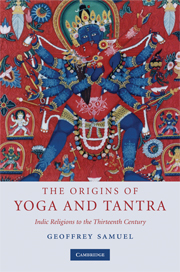Book contents
- Frontmatter
- Contents
- List of figures
- Preface
- 1 Introduction
- 2 Stories and sources
- PART ONE MEDITATION AND YOGA
- 3 The Second Urbanisation of South Asia
- 4 Two worlds and their interactions
- 5 Religion in the early states
- 6 The origins of the Buddhist and Jaina orders
- 7 The Brahmanical alternative
- 8 Interlude: Asceticism and celibacy in Indic religions
- PART TWO TANTRA
- References
- Index
7 - The Brahmanical alternative
Published online by Cambridge University Press: 05 June 2012
- Frontmatter
- Contents
- List of figures
- Preface
- 1 Introduction
- 2 Stories and sources
- PART ONE MEDITATION AND YOGA
- 3 The Second Urbanisation of South Asia
- 4 Two worlds and their interactions
- 5 Religion in the early states
- 6 The origins of the Buddhist and Jaina orders
- 7 The Brahmanical alternative
- 8 Interlude: Asceticism and celibacy in Indic religions
- PART TWO TANTRA
- References
- Index
Summary
I referred in Chapter 6 to Brahmanical asceticism, but did not go into much detail about how it was practised and understood, and how it related to the ‘Vedic’ pattern of religion developing in the Kuru-Pañcāla region. In this chapter I explore the development of asceticism on the Brahmanical side in more detail, and discuss how Brahmanical thinkers and priests responded to the challenge of the śramaṇa traditions which we considered in Chapter 6. At the end of this chapter, I look at the way in which the Brahmanical alternative related to regional and local deities and cults, contrasting its approach to the Buddhist and Jain approach sketched in Chapter 6.
VARIETIES OF BRAHMINS
I referred in Chapter 6 to the indications of a variety of different Brahmin roles in the fifth and fourth centuries BCE or thereabouts, and mentioned Patrick Olivelle's demonstration in his book The Āśrama System that the so-called āśramas originally represented alternative ways of life rather than a sequence of stages through which all men of the Vedic elite groups (Brahmin, kṣatriya, vaiśya) should progress (Olivelle 1993). Olivelle notes that there ‘appear to have been tensions and rivalries between the traditional Brahmins of the villages, who were the heirs and guardians of the vedic world, and the newly-urbanized Brahmins’ (1993: 59). Elsewhere in The Āśrama System, Olivelle points to the references in Buddhist and Brahmanical sources to married semi-renunciate Brahmins, characterised by their matted or braided hair (jaṭila) hairstyle, living in uninhabited areas outside towns with their wives and children.
- Type
- Chapter
- Information
- The Origins of Yoga and TantraIndic Religions to the Thirteenth Century, pp. 153 - 172Publisher: Cambridge University PressPrint publication year: 2008



